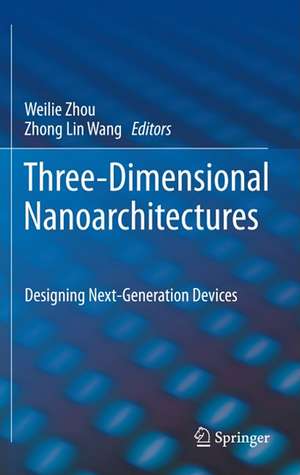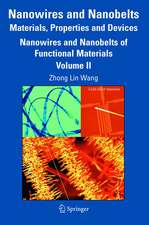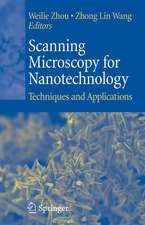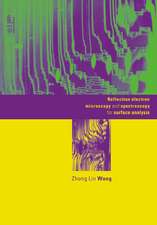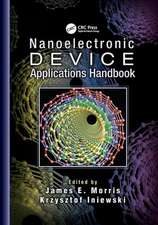Three-Dimensional Nanoarchitectures: Designing Next-Generation Devices
Editat de Weilie Zhou, Zhong Lin Wangen Limba Engleză Hardback – 3 aug 2011
| Toate formatele și edițiile | Preț | Express |
|---|---|---|
| Paperback (1) | 804.32 lei 38-44 zile | |
| Springer – 22 aug 2016 | 804.32 lei 38-44 zile | |
| Hardback (1) | 821.40 lei 38-44 zile | |
| Springer – 3 aug 2011 | 821.40 lei 38-44 zile |
Preț: 821.40 lei
Preț vechi: 1080.80 lei
-24% Nou
Puncte Express: 1232
Preț estimativ în valută:
157.18€ • 164.44$ • 130.57£
157.18€ • 164.44$ • 130.57£
Carte tipărită la comandă
Livrare economică 29 martie-04 aprilie
Preluare comenzi: 021 569.72.76
Specificații
ISBN-13: 9781441998217
ISBN-10: 1441998217
Pagini: 556
Ilustrații: XVIII, 538 p. 359 illus., 238 illus. in color.
Dimensiuni: 155 x 235 x 28 mm
Greutate: 1.04 kg
Ediția:2011
Editura: Springer
Colecția Springer
Locul publicării:New York, NY, United States
ISBN-10: 1441998217
Pagini: 556
Ilustrații: XVIII, 538 p. 359 illus., 238 illus. in color.
Dimensiuni: 155 x 235 x 28 mm
Greutate: 1.04 kg
Ediția:2011
Editura: Springer
Colecția Springer
Locul publicării:New York, NY, United States
Public țintă
ResearchCuprins
1. Building Three dimensional Nanostructured Devices by Self-Assembly by Steve Hu, Jeong-Hyun Cho and David H. Gracias
Summary
1.1.0 The pressing need for three dimensional patterned nanofabrication
1.2.0 Self-assembly using molecular linkages
1.2.1 Three dimensional self-assembly using protein linkages
1.2.2 Three dimensional self-assembly with DNA linkages
1.3.0 Three dimensional self-assembly using physical forces
1.4.0 Three dimensional patterned nanofabrication by curving and bending nanostructures
1.4.1 Curving hingeless nanostructures using stress
1.4.2 Three dimensional nanofabrication by bending hinged panels to create patterned polyhedral nanoparticles
1.5.0 Conclusions
Acknowledgements
References
2. Bio-inspired Three-Dimensional Nanoarchitectures by Jian Shi and Xudong Wang
2.1 Introduction
2.2 Historical Perspective
2.3 Bio-inspired Nanophotonics
2.3.1 Photonic Crystals
2.3.2 Color Mine in Nature
2.3.3 Natural Photonic Crystals
2.4 Bio-inspired Fabrication of Nanostrctures
2.4.1 Biomineralization
2.4.2 Biological Fine Structure Duplication
2.5 Bio-inspired Functionality
2.6 Conclusion
References
3. Building 3D Micro- and Nanostructures through Nanoimprint by Xing Cheng
3.1 Introduction to 3D structure fabrication through nanoimprint
3.2 Overview of nanoimprint lithography
3.2.1 Fundamentals of nanoimprint lithography
3.2.2 Materials for nanoimprint lithography]
3.3 Building 3D Nanostructures by Nanoimprint
3.3.1 Direct patterning of 3D structures in one step
3.3.1.1 Replicating 3D polymer structures from 3D templates
3.3.1.2 Applications of 3D polymer structures by one-step nanoimprint
3.3.2 Building 3D nanostructures by transfer bonding and sequential layer stacking
3.3.2.1 Principles of transfer bonding and sequential layerstacking
3.3.2.2 3D structures built by transfer bonding and sequential layer stacking
3.3.2.3 Defect modes and process yield of transfer bonding and sequential layer stacking
3.3.3 Building 3D nanostructures by two consecutive nanoimprints
3.4 Summary and future outlook
References
4. Electrochemical Growth of Nanostructured Materials by Jin-Hee Lim and John B. Wiley
4.1 Magnetic Nanomaterials
4.2 Semiconductor Nanostructures
4.3 Thermoelectric Nanomaterials
4.4 Conducting Polymer Nanostructures
4.5 Nanotube and Core-Shell Nanostructures
4.6 Porous Au Nanowires
4.7 Modification of Nanowires
4.8 Functionalization of Nanowires
4.9 Nanostructure Arrays on Substrates
4.10 Patterning of Nanowires
Acknowledgment
5. Three dimensional micro/nanomaterials generated by fiber drawing nanomanufacturing by Zeyu Ma, Yan Hong, Shujiang Ding, Minghui Zhang, Maniul Hossain, Ming Su
5.1 Introduction
5.2 Fiber draw tower
5.3 Materials selections
5.4 Drawing process
5.5 Size design
5.6 3D assembling
5.7 Metallic nanowires
5.8 Semiconductor nanowires
5.9 Glass microchannel array
5.10 Differential etching of glasses
5.11 Glass microspike array
5.12 Hybrid glass membranes
5.13 Textured structure of encapsulated paraffin wax microfiber
5.14 Conclusions
References
6.0 One-Dimensional Metal Oxide Nanostructures for Photoelectrochemical Hydrogen Generation by Yat Li
6.1 Introduction
6.1.1 Photoelectrochemical hydrogen generation6.1.2 Challenges in Metal Oxide based PEC hydrogen generation
6.1.3 One-Dimensional Nanomaterials for Photoelectrodes
6.2 Pristine Metal Oxide Nanowire/Nanotube-Arrayed Photoelectrodes
6.2.1 Nanowire arrayed photoelectrodes
6.2.1.1 Hematite (α-Fe2O3)
6.2.1.2. Titanium Oxide (TiO2) and Zinc Oxide (ZnO)6.2.1.3. Tungsten Trioxide (WO3)
6.2.2 Nanotube arrayed photoelectrodes
6.3 Element-Doped Metal Oxide 1D Nanostructures
6.3.1 TiO2 nanostructures
6.3.2. ZnO nanostructures
6.3.3 Hematite (α-Fe2O3) nanostructures
6.4 Quantum Dot Sensitizations
6.4.1 Background
6.4.2 Quantum Dot Sensitized ZnO Nanowires
6.4.3 Quantum Dot Co-Sensitized Nanowires
6.4.4 Double-sided Quantum Dot Sensitization
6.5 Synergistic Effect of Quantum Dot Sensitization and Elemental Doping
6.6 Concluding Remarks
References
7. Helical Nanostructures: Synthesis and Potential Applications by Pu-Xian Gao and Gang Liu
7.1 Introduction
7.2 Semiconductor nanohelices
7.2.1 ZnO nanohelices
7.2.1.1 Superlattice-structured ZnO nanohelices
7.2.1.2 Superelasticity, nanobuckling and non-linear electronic transport properties of superlattice-structured ZnO nanohelices
7.2.1.2.1 Superelasticity of superlattice-structured ZnO nanohelix
7.2.1.2.2 Nanobuckling and fracture of superlattice-structured ZnO nanohelix
7.2.1.2.3 Non-linear electronic transport of superlattice-structured ZnO nanohelix
7.2.1.3 Other ZnO nanohelices
7.2.4 InP nanohelices
7.2.2 SiO2 nanohelices
7.2.3 CdS nanohelices
7.2.4 InP nanohelices
7.2.5 Ga2O3 nanohelices
7.3 Carbon-related nanohelices
7.3.1 Helical carbon nanoribbon/nanocoil
7.3.2 Helical carbon nanotube
7.3.3 Tungsten-containing carbon (WC) nanospring
7.4 Other nanohelices
7.4.1 Helical SiC/SiO2 core-shell nanowires and Si3N4 microcoils
7.4.2 MgB2 nanohelices
7.4.3 Si spirals
7.5 Potential applications7.6 Summary
Acknowledgement
References
8. Hierarchical 3D Nanostructure Organization for Next Generation Devices by Eric N. Dattoli and Wei Lu8.1 Introduction
8.2 Fluidic Flow - Assisted Assembly
8.2.1 Drop-Drying
8.2.2 Channel-Confined Fluidic Flow
8.2.3 Blown Bubble Film Transfer
8.3 Nematic Liquid Crystal – Induced Assembly
8.4 Langmuir-Blodgett Assembly
8.5 Dielectrophoresis – Assembly
8.6 Chemical Affinity and Electrostatic Interaction - directed
Assembly
8.7 Contact Transfer
8.7.1 Shear-assisted Contact Printing
8.7.2 Stamp Transfer
8.8 Directed Growth
8.8.1 Horizontal Growth
8.8.2 Vertical Growth
8.9 Device Applications
8.9.1 Thin-Film Transistor
8.9.1.1 Performance considerations for NW- or NT- based TFTs
8.9.1.2 Transparent Nanowire-based TFTs
8.9.1.3 CNT-based TFTs
8.9.2 3D, Multilayer Device Structures
8.9.3 Sensors8.9.4 Vertical Nanowire Field Effect Transistors (FETs)
8.10 Conclusion
References
9. Strain-induced Self Rolled-up Semiconductor Microtube Resonators: A New Architecture for Photonic Device Applications by Xin Miao, Ik Su Chun, and Xiuling Li
9.1 Introductions
9.2 Formation Process
9.3 Photonic Applications of Rolled-up Semiconductor Tubes
9.3.1 Spontaneous emission from quantum well microtubes: intensity enhancement and energy shift
9.3.2 Optical resonance modes in rolled-up microtube ring cavity
9.3.3 Optically pumped lasing from rolled-up microtube ring cavity
10. Carbon Nanotube Arrays: Synthesis, Properties and Applications by Suman Neupane, Wenzhi Li
10.1 Introduction
10.2 Carbon Nanotube Synthesis
10.2.1 Arc discharge
10.2.2 Laser ablation
10.2.3 Electrochemical synthesis
10.2.4 Diffusion flame synthesis
10.2.5 Chemical vapor deposition
10.3 Carbon Nanotube Arrays
10.3.1 CNTA synthesis using patterned catalyst arrays
10.3.1.1 Pulsed laser deposition
10.3.1.2 Anodic aluminum oxide (AAO) templates
10.3.1.3 Reversemicelle method
10.3.1.4 Photolithography
10.3.1.5 Electrochemical etching
10.3.1.6 Sputtering
10.3.1.7 Nanosphere lithography
10.3.1.8 Sol-gel method
10.3.2 CNTA synthesis by other methods
10.3.3 Horizontal arrays of CNTs
10.4 Mechanical Properties
10.5 Thermal Properties
10.6 Electrical properties10.7 Applications of CNTs and CNTAs
10.7.1 Hydrogen storage
10.7.2 CNTs as Sensors
10.7.3 CNTs for battery and supercapacitor applications
10.7.4 CNTs for photovoltaic device
10.8 Conclusions
References
11. Molecular Rotors Observed by Scanning Tunneling Microscopy by Ye-liang Wang, Qi Liu, Hai-gang Zhang, Hai-ming Guo, Hong-jun Gao
Abstract
11.1 Introduction
11.2 Solution-based and surface-mounted molecule machines
11.3 Single molecular rotors at surfaces
11.3.1 A monomolecular rotor in supramolecular network
11.3.2 Gear-like rotation of molecular rotor along the edge of molecular island
11.3.3 Thermal-driven rotation on reconstructed-surface template
11.3.4 STM-driven rotation on reconstructed-surface template
11.3.5 Molecular rotors with variable rotation radii
11.3.6 Rolling motion of a single molecule at surface
11.4 Array of molecular motors at surfaces
11.5 Outlook
11.6 Conclusion
Acknowledgements
References
12. Nanophotonic Devices Based on ZnO Nanowires by Qing Yang and Zhong Lin Wang
12.1 Introduction
12.2 Pure optical devices based on ZnO NWs
12.2.1 ZnO NW subwavelength waveguides and their applications
12.2.2 Optical pumped lasers in ZnO NWs
12.2.3 Nonlinear optical devices based on ZnO NWs
12.3 Optoelectronic devices based ZnO NWs
12.3.1 ZnO NW ultra-sensitive UV and Infrared PDs
12.3.2 Dye-sensitized solar cells based on ZnO NWs
12.3.3 Single ZnO NW and NW array light emitting diodes
12.3.4 Electricallypumped random lasing from ZnO nanorod arrays
12.4 Piezo-phototronic devices based on ZnO NWs
12.4.1 Optimizing the power output of a ZnO photocell by piezopotential
12.4.2 Enhancing Sensitivity of a Single ZnO Micro-/NW Photodetector by Piezo-phototronic effect
12.5 Conclusions
References
13. Nanostructured Light Management for Advanced Photovoltaics by Jia Zhu, Zongfu Yu, Sangmoo Jeong, Ching-Mei Hsu, Shanui Fan, Yi Cui
Abstract
13.1 Introduction
13.2 Fabrication of Nanowire and Nanocone Arrays
13.2.1 Method
13.2.2 Shape Control: Nanowires and Nanocones
13.2.3 Diameter and Spacing Control
13.2.4 Large Scale Process
13.3 Photon Management: Anti-reflection
13.3.1 Nanowires
13.3.2 Nanocones
13.4 Photon Management: Absorption Enhancement
13.4.1 Different Mechanisms
13.4.2 Nanodome Structures
13.5 Solar Cell performance
13.6 Fundamental Limit of Light-trapping in Nanophotonics
13.7 Summary and Outlook
References
14. Highly Sensitive and Selective Gas Detection by 3D Metal Oxide Nanoarchitectures by Jiajun Chen, Kai Wang, Baobao Cao, Dr. Weilie Zhou
14.1 Introduction
14.2 Highly Sensitive Gas Detection by Standalone 3D Nanosensors
14.2.1 Metal Oxide Nanowire / Nanotube Array Gas Sensors
14.2.1.1 Nanowire Arrays
14.2.1.2 Nanotube Arrays
14.2.2 Gas Sensors Based on Opal and Inverted Opal Nanostructures
14.3 Sensor Arrays Based on 3D Nanostructured Gas Sensors
14.4 Conclusion Remarks
AcknowledgementReferences
15. Quantum Dot Sensitized Three Dimensional Nanostructures for Photovoltaic Applications by Jun Wang, Xukai Xin, Daniel Vennerberg, Zhiqun Lin
15.1 Introduction
15.2 Quantum dot sensitized solar cells
15.2.1 Overview
15.2.2 Synthesis of quantum dots and surface functionalization
15.2.3 Quantum dot sensitized nanoparticle films
15.2.4Quantum dot sensitized nanowire arrays
15.2.5 Quantum dot sensitized nanotube arrays
15.2.6 Investigation of charge injection in quantum dot sensitized solar cells
15.2.6.1 Generation of excited electrons
15.2.6.2 Recombination and transportation of excited electrons
15.3 Outlook
References
16. Three Dimensional Photovoltaic Devices Based on Vertically Aligned Nanowire Array by Kai Wang, Jiajun Chen, Satish Chandra Rai, and Weilie Zhou
16.1 Introduction
16.2 Photovoltaic devices based on heteroepitaxial-grown nanowire array integrated with the substrate
16.3 Photovoltaic devices based on axial nanowire array
16.4 Photovoltaic devices based on nanowire array embedded in thin film
16.5 Photovoltaic devices based on nanowire array with core-shell structure
16.5.1 P-N core-shell homojuntion photovoltaic devices
16.5.2 Type II core-shell heterojuntion photovoltaic devices
16.5.2.1 Synthesis of ZnO/ZnSe and ZnO/ZnS core-shell nanowire array
16.5.2.2 Structural and optical properties of ZnO/ZnSe core-shell nanowire array
16.5.2.3 Photoresponse of ZnO/ZnSe nanowire array
16.5.2.4 Morphologies, structure and optical properties of ZnO/ZnS nanowire array
16.5.2.5 Photovoltaic effect of ZnO/ZnS nanowire array
16.6. Summary and perspectives
Acknowledgements
References
17. Supercapacitors Based on 3D Nanostructrued Electrodes by Hao Zhang, Gaoping Cao, Yusheng Yang
17.1 Supercapacitors
17.2 Electrochemical double layer capacitors based on 3D Nanostructrued electrodes
17.2.1 Electrodes based on activated carbons and activated carbon fibers: powdered carbons with disordered pore structures
17.2.2 Electrodes based on carbon foams, carbon areogels, and other monolithic carbon: monolithic carbon with disordered micropores
17.2.3 Electrodes based on template carbons, graphene, carbide-derivedcarbons, and hierarchical porous carbons: powdered carbons with high mesopore ratios or reasonable PSD
17.2.4 Electrodes based on carbon nanotubes: monolithic carbons with developed mesoporous structures
17.3 Pseudocapacitors based on 3D Nanostructrued electrodes
17.3.1 Nanostructured metal oxide electrode materials
17.3.2 Nanostructured conducting polymer electrodes materials
17.4 Hybrid capacitors based on 3D Nanostructrued electrodes
17.4.1 Nanostructured electrodes based on metal oxides/carbon composite
17.4.2 Nanostructured electrodes based on polymers/carbon composites
17.5 Conclusions and perspectives
References
18. Aligned Ni Coated Single Wall Carbon Nanotubes under Magnetic Field for Coolant Applications by Haiping Hong and Mark Horton
18.1 Introduction
18.2 Experimental
18.3 Results and Discussion
18.3.1 Thermal Conductivity of Nanofluids Containing Ni-coated Nanotubes
18.3.2 Evidence of Magnetic Alignment of Ni-coated Nanotubes
18.4 Conclusion
18.5 Acknowledgements
References
Summary
1.1.0 The pressing need for three dimensional patterned nanofabrication
1.2.0 Self-assembly using molecular linkages
1.2.1 Three dimensional self-assembly using protein linkages
1.2.2 Three dimensional self-assembly with DNA linkages
1.3.0 Three dimensional self-assembly using physical forces
1.4.0 Three dimensional patterned nanofabrication by curving and bending nanostructures
1.4.1 Curving hingeless nanostructures using stress
1.4.2 Three dimensional nanofabrication by bending hinged panels to create patterned polyhedral nanoparticles
1.5.0 Conclusions
Acknowledgements
References
2. Bio-inspired Three-Dimensional Nanoarchitectures by Jian Shi and Xudong Wang
2.1 Introduction
2.2 Historical Perspective
2.3 Bio-inspired Nanophotonics
2.3.1 Photonic Crystals
2.3.2 Color Mine in Nature
2.3.3 Natural Photonic Crystals
2.4 Bio-inspired Fabrication of Nanostrctures
2.4.1 Biomineralization
2.4.2 Biological Fine Structure Duplication
2.5 Bio-inspired Functionality
2.6 Conclusion
References
3. Building 3D Micro- and Nanostructures through Nanoimprint by Xing Cheng
3.1 Introduction to 3D structure fabrication through nanoimprint
3.2 Overview of nanoimprint lithography
3.2.1 Fundamentals of nanoimprint lithography
3.2.2 Materials for nanoimprint lithography]
3.3 Building 3D Nanostructures by Nanoimprint
3.3.1 Direct patterning of 3D structures in one step
3.3.1.1 Replicating 3D polymer structures from 3D templates
3.3.1.2 Applications of 3D polymer structures by one-step nanoimprint
3.3.2 Building 3D nanostructures by transfer bonding and sequential layer stacking
3.3.2.1 Principles of transfer bonding and sequential layerstacking
3.3.2.2 3D structures built by transfer bonding and sequential layer stacking
3.3.2.3 Defect modes and process yield of transfer bonding and sequential layer stacking
3.3.3 Building 3D nanostructures by two consecutive nanoimprints
3.4 Summary and future outlook
References
4. Electrochemical Growth of Nanostructured Materials by Jin-Hee Lim and John B. Wiley
4.1 Magnetic Nanomaterials
4.2 Semiconductor Nanostructures
4.3 Thermoelectric Nanomaterials
4.4 Conducting Polymer Nanostructures
4.5 Nanotube and Core-Shell Nanostructures
4.6 Porous Au Nanowires
4.7 Modification of Nanowires
4.8 Functionalization of Nanowires
4.9 Nanostructure Arrays on Substrates
4.10 Patterning of Nanowires
Acknowledgment
5. Three dimensional micro/nanomaterials generated by fiber drawing nanomanufacturing by Zeyu Ma, Yan Hong, Shujiang Ding, Minghui Zhang, Maniul Hossain, Ming Su
5.1 Introduction
5.2 Fiber draw tower
5.3 Materials selections
5.4 Drawing process
5.5 Size design
5.6 3D assembling
5.7 Metallic nanowires
5.8 Semiconductor nanowires
5.9 Glass microchannel array
5.10 Differential etching of glasses
5.11 Glass microspike array
5.12 Hybrid glass membranes
5.13 Textured structure of encapsulated paraffin wax microfiber
5.14 Conclusions
References
6.0 One-Dimensional Metal Oxide Nanostructures for Photoelectrochemical Hydrogen Generation by Yat Li
6.1 Introduction
6.1.1 Photoelectrochemical hydrogen generation6.1.2 Challenges in Metal Oxide based PEC hydrogen generation
6.1.3 One-Dimensional Nanomaterials for Photoelectrodes
6.2 Pristine Metal Oxide Nanowire/Nanotube-Arrayed Photoelectrodes
6.2.1 Nanowire arrayed photoelectrodes
6.2.1.1 Hematite (α-Fe2O3)
6.2.1.2. Titanium Oxide (TiO2) and Zinc Oxide (ZnO)6.2.1.3. Tungsten Trioxide (WO3)
6.2.2 Nanotube arrayed photoelectrodes
6.3 Element-Doped Metal Oxide 1D Nanostructures
6.3.1 TiO2 nanostructures
6.3.2. ZnO nanostructures
6.3.3 Hematite (α-Fe2O3) nanostructures
6.4 Quantum Dot Sensitizations
6.4.1 Background
6.4.2 Quantum Dot Sensitized ZnO Nanowires
6.4.3 Quantum Dot Co-Sensitized Nanowires
6.4.4 Double-sided Quantum Dot Sensitization
6.5 Synergistic Effect of Quantum Dot Sensitization and Elemental Doping
6.6 Concluding Remarks
References
7. Helical Nanostructures: Synthesis and Potential Applications by Pu-Xian Gao and Gang Liu
7.1 Introduction
7.2 Semiconductor nanohelices
7.2.1 ZnO nanohelices
7.2.1.1 Superlattice-structured ZnO nanohelices
7.2.1.2 Superelasticity, nanobuckling and non-linear electronic transport properties of superlattice-structured ZnO nanohelices
7.2.1.2.1 Superelasticity of superlattice-structured ZnO nanohelix
7.2.1.2.2 Nanobuckling and fracture of superlattice-structured ZnO nanohelix
7.2.1.2.3 Non-linear electronic transport of superlattice-structured ZnO nanohelix
7.2.1.3 Other ZnO nanohelices
7.2.4 InP nanohelices
7.2.2 SiO2 nanohelices
7.2.3 CdS nanohelices
7.2.4 InP nanohelices
7.2.5 Ga2O3 nanohelices
7.3 Carbon-related nanohelices
7.3.1 Helical carbon nanoribbon/nanocoil
7.3.2 Helical carbon nanotube
7.3.3 Tungsten-containing carbon (WC) nanospring
7.4 Other nanohelices
7.4.1 Helical SiC/SiO2 core-shell nanowires and Si3N4 microcoils
7.4.2 MgB2 nanohelices
7.4.3 Si spirals
7.5 Potential applications7.6 Summary
Acknowledgement
References
8. Hierarchical 3D Nanostructure Organization for Next Generation Devices by Eric N. Dattoli and Wei Lu8.1 Introduction
8.2 Fluidic Flow - Assisted Assembly
8.2.1 Drop-Drying
8.2.2 Channel-Confined Fluidic Flow
8.2.3 Blown Bubble Film Transfer
8.3 Nematic Liquid Crystal – Induced Assembly
8.4 Langmuir-Blodgett Assembly
8.5 Dielectrophoresis – Assembly
8.6 Chemical Affinity and Electrostatic Interaction - directed
Assembly
8.7 Contact Transfer
8.7.1 Shear-assisted Contact Printing
8.7.2 Stamp Transfer
8.8 Directed Growth
8.8.1 Horizontal Growth
8.8.2 Vertical Growth
8.9 Device Applications
8.9.1 Thin-Film Transistor
8.9.1.1 Performance considerations for NW- or NT- based TFTs
8.9.1.2 Transparent Nanowire-based TFTs
8.9.1.3 CNT-based TFTs
8.9.2 3D, Multilayer Device Structures
8.9.3 Sensors8.9.4 Vertical Nanowire Field Effect Transistors (FETs)
8.10 Conclusion
References
9. Strain-induced Self Rolled-up Semiconductor Microtube Resonators: A New Architecture for Photonic Device Applications by Xin Miao, Ik Su Chun, and Xiuling Li
9.1 Introductions
9.2 Formation Process
9.3 Photonic Applications of Rolled-up Semiconductor Tubes
9.3.1 Spontaneous emission from quantum well microtubes: intensity enhancement and energy shift
9.3.2 Optical resonance modes in rolled-up microtube ring cavity
9.3.3 Optically pumped lasing from rolled-up microtube ring cavity
10. Carbon Nanotube Arrays: Synthesis, Properties and Applications by Suman Neupane, Wenzhi Li
10.1 Introduction
10.2 Carbon Nanotube Synthesis
10.2.1 Arc discharge
10.2.2 Laser ablation
10.2.3 Electrochemical synthesis
10.2.4 Diffusion flame synthesis
10.2.5 Chemical vapor deposition
10.3 Carbon Nanotube Arrays
10.3.1 CNTA synthesis using patterned catalyst arrays
10.3.1.1 Pulsed laser deposition
10.3.1.2 Anodic aluminum oxide (AAO) templates
10.3.1.3 Reversemicelle method
10.3.1.4 Photolithography
10.3.1.5 Electrochemical etching
10.3.1.6 Sputtering
10.3.1.7 Nanosphere lithography
10.3.1.8 Sol-gel method
10.3.2 CNTA synthesis by other methods
10.3.3 Horizontal arrays of CNTs
10.4 Mechanical Properties
10.5 Thermal Properties
10.6 Electrical properties10.7 Applications of CNTs and CNTAs
10.7.1 Hydrogen storage
10.7.2 CNTs as Sensors
10.7.3 CNTs for battery and supercapacitor applications
10.7.4 CNTs for photovoltaic device
10.8 Conclusions
References
11. Molecular Rotors Observed by Scanning Tunneling Microscopy by Ye-liang Wang, Qi Liu, Hai-gang Zhang, Hai-ming Guo, Hong-jun Gao
Abstract
11.1 Introduction
11.2 Solution-based and surface-mounted molecule machines
11.3 Single molecular rotors at surfaces
11.3.1 A monomolecular rotor in supramolecular network
11.3.2 Gear-like rotation of molecular rotor along the edge of molecular island
11.3.3 Thermal-driven rotation on reconstructed-surface template
11.3.4 STM-driven rotation on reconstructed-surface template
11.3.5 Molecular rotors with variable rotation radii
11.3.6 Rolling motion of a single molecule at surface
11.4 Array of molecular motors at surfaces
11.5 Outlook
11.6 Conclusion
Acknowledgements
References
12. Nanophotonic Devices Based on ZnO Nanowires by Qing Yang and Zhong Lin Wang
12.1 Introduction
12.2 Pure optical devices based on ZnO NWs
12.2.1 ZnO NW subwavelength waveguides and their applications
12.2.2 Optical pumped lasers in ZnO NWs
12.2.3 Nonlinear optical devices based on ZnO NWs
12.3 Optoelectronic devices based ZnO NWs
12.3.1 ZnO NW ultra-sensitive UV and Infrared PDs
12.3.2 Dye-sensitized solar cells based on ZnO NWs
12.3.3 Single ZnO NW and NW array light emitting diodes
12.3.4 Electricallypumped random lasing from ZnO nanorod arrays
12.4 Piezo-phototronic devices based on ZnO NWs
12.4.1 Optimizing the power output of a ZnO photocell by piezopotential
12.4.2 Enhancing Sensitivity of a Single ZnO Micro-/NW Photodetector by Piezo-phototronic effect
12.5 Conclusions
References
13. Nanostructured Light Management for Advanced Photovoltaics by Jia Zhu, Zongfu Yu, Sangmoo Jeong, Ching-Mei Hsu, Shanui Fan, Yi Cui
Abstract
13.1 Introduction
13.2 Fabrication of Nanowire and Nanocone Arrays
13.2.1 Method
13.2.2 Shape Control: Nanowires and Nanocones
13.2.3 Diameter and Spacing Control
13.2.4 Large Scale Process
13.3 Photon Management: Anti-reflection
13.3.1 Nanowires
13.3.2 Nanocones
13.4 Photon Management: Absorption Enhancement
13.4.1 Different Mechanisms
13.4.2 Nanodome Structures
13.5 Solar Cell performance
13.6 Fundamental Limit of Light-trapping in Nanophotonics
13.7 Summary and Outlook
References
14. Highly Sensitive and Selective Gas Detection by 3D Metal Oxide Nanoarchitectures by Jiajun Chen, Kai Wang, Baobao Cao, Dr. Weilie Zhou
14.1 Introduction
14.2 Highly Sensitive Gas Detection by Standalone 3D Nanosensors
14.2.1 Metal Oxide Nanowire / Nanotube Array Gas Sensors
14.2.1.1 Nanowire Arrays
14.2.1.2 Nanotube Arrays
14.2.2 Gas Sensors Based on Opal and Inverted Opal Nanostructures
14.3 Sensor Arrays Based on 3D Nanostructured Gas Sensors
14.4 Conclusion Remarks
AcknowledgementReferences
15. Quantum Dot Sensitized Three Dimensional Nanostructures for Photovoltaic Applications by Jun Wang, Xukai Xin, Daniel Vennerberg, Zhiqun Lin
15.1 Introduction
15.2 Quantum dot sensitized solar cells
15.2.1 Overview
15.2.2 Synthesis of quantum dots and surface functionalization
15.2.3 Quantum dot sensitized nanoparticle films
15.2.4Quantum dot sensitized nanowire arrays
15.2.5 Quantum dot sensitized nanotube arrays
15.2.6 Investigation of charge injection in quantum dot sensitized solar cells
15.2.6.1 Generation of excited electrons
15.2.6.2 Recombination and transportation of excited electrons
15.3 Outlook
References
16. Three Dimensional Photovoltaic Devices Based on Vertically Aligned Nanowire Array by Kai Wang, Jiajun Chen, Satish Chandra Rai, and Weilie Zhou
16.1 Introduction
16.2 Photovoltaic devices based on heteroepitaxial-grown nanowire array integrated with the substrate
16.3 Photovoltaic devices based on axial nanowire array
16.4 Photovoltaic devices based on nanowire array embedded in thin film
16.5 Photovoltaic devices based on nanowire array with core-shell structure
16.5.1 P-N core-shell homojuntion photovoltaic devices
16.5.2 Type II core-shell heterojuntion photovoltaic devices
16.5.2.1 Synthesis of ZnO/ZnSe and ZnO/ZnS core-shell nanowire array
16.5.2.2 Structural and optical properties of ZnO/ZnSe core-shell nanowire array
16.5.2.3 Photoresponse of ZnO/ZnSe nanowire array
16.5.2.4 Morphologies, structure and optical properties of ZnO/ZnS nanowire array
16.5.2.5 Photovoltaic effect of ZnO/ZnS nanowire array
16.6. Summary and perspectives
Acknowledgements
References
17. Supercapacitors Based on 3D Nanostructrued Electrodes by Hao Zhang, Gaoping Cao, Yusheng Yang
17.1 Supercapacitors
17.2 Electrochemical double layer capacitors based on 3D Nanostructrued electrodes
17.2.1 Electrodes based on activated carbons and activated carbon fibers: powdered carbons with disordered pore structures
17.2.2 Electrodes based on carbon foams, carbon areogels, and other monolithic carbon: monolithic carbon with disordered micropores
17.2.3 Electrodes based on template carbons, graphene, carbide-derivedcarbons, and hierarchical porous carbons: powdered carbons with high mesopore ratios or reasonable PSD
17.2.4 Electrodes based on carbon nanotubes: monolithic carbons with developed mesoporous structures
17.3 Pseudocapacitors based on 3D Nanostructrued electrodes
17.3.1 Nanostructured metal oxide electrode materials
17.3.2 Nanostructured conducting polymer electrodes materials
17.4 Hybrid capacitors based on 3D Nanostructrued electrodes
17.4.1 Nanostructured electrodes based on metal oxides/carbon composite
17.4.2 Nanostructured electrodes based on polymers/carbon composites
17.5 Conclusions and perspectives
References
18. Aligned Ni Coated Single Wall Carbon Nanotubes under Magnetic Field for Coolant Applications by Haiping Hong and Mark Horton
18.1 Introduction
18.2 Experimental
18.3 Results and Discussion
18.3.1 Thermal Conductivity of Nanofluids Containing Ni-coated Nanotubes
18.3.2 Evidence of Magnetic Alignment of Ni-coated Nanotubes
18.4 Conclusion
18.5 Acknowledgements
References
Textul de pe ultima copertă
Devices built from three-dimensional nanoarchitectures offer a number of advantages over those based on thin-film technology, such as larger surface area to enhance the sensitivity of sensors, to collect more sunlight to improve the efficiency of solar cells, and to supply higher density emitters for increased resolution in flat panel displays. Three-dimensional nanoscale assembly has already been used to generate many prototypes of devices and sensors, including piezoelectric nanogenerators based on ZnO nanowire arrays, photovoltaic devices based on silicon nanowire array p-n junctions, and highly sensitive gas sensors based on metal oxide nanowire arrays among others. Three-Dimensional Nanoarchitectures: Designing Next-Generation Devices describes state-of-the-art synthesis, integration, and design strategies used to create three-dimensional nanoarchitectures for functional nanodevice applications. With a focus on synthesis and fabrication methods for three-dimensional nanostructure assembly and construction, coverage includes resonators, nanophotonics, sensors, supercapacitors, solar cells, and more. This book is an essential reference for a broad audience of researchers in materials science, chemistry, physics, and electrical engineering who want the latest information on synthesis routes and assembly methods. Schematics of device integration and mechanisms as well as plots of measurement data are included.
Caracteristici
Presents the strategies and methods for developing next-generation nanotechnology Covers the growth of nanoarchitectures and novel device fabrication Includes a wide variety of applications from nanophotonics and sensor technology to supercapacitor and solar cells Includes supplementary material: sn.pub/extras
